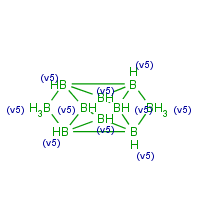Decaborane
Agent Name
Decaborane
CAS Number
17702-41-9
Formula
B10-H14
Major Category
Metals

Synonyms
Boron hydride (B10H14); Decaborane(14); Decaboron tetradecahydride; Tetradecahydrodecaborane; nido-Decaborane(14); [ChemIDplus] UN1868
Category
Metalloid Compounds (Boron)
Description
Colorless to white crystalline solid with an intense, bitter, chocolate-like odor; [NIOSH] White powder with a pungent odor; [Alfa Aesar MSDS]
Sources/Uses
Decaborane is used as a polymer catalyst and rocket fuel additive. [ACGIH] Used as catalyst, corrosion inhibitor, fuel additive, stabilizer, rayon delustrant, mothproofing agent, dye-stripping agent, reducing agent, fluxing agent, oxygen scavenger, and propellant; [Hawley]
Comments
Toxic effects to the central nervous system, liver, and kidneys are observed in animals exposed through the skin and inhalation routes. Incoordination, tremors, and seizures have been reported in workers exposed to decaborane. Because of rapid olfactory fatigue, the odor is not a dependable warning. [ACGIH] Highly reactive; [Merck Index] Produces hydrogen gas on reaction with water or moisture; Aerosol is a skin, eye, and respiratory tract irritant; May cause CNS effects; Exposure limit value exceeded without sufficient odor warning; [ICSC] A skin, eye, and respiratory tract irritant; [HSDB] Releases hydrogen gas on contact with water; An irritant; Highly toxic by inhalation; Toxic by ingestion and skin absorption; [Alfa Aesar MSDS]
Reference Link #1
Biomedical References
Exposure Assessment
Skin Designation (ACGIH)
Yes
TLV (ACGIH)
0.05 ppm
STEL (ACGIH)
0.15 ppm
PEL (OSHA)
0.05 ppm
MAK
0.05 ppm
IDLH (NIOSH)
3 ppm
Excerpts from Documentation for IDLHs
Basis for original (SCP) IDLH: The chosen IDLH is based on the statement by ILO [1971] that the 4hour LC50 was 122 to 230 mg/m3 for small animals. . . . Basis for revised IDLH: The revised IDLH for decaborane is 15 mg/m3 based on acute inhalation toxicity data in animals [Schechter 1958].
Vapor Pressure
0.05 mm Hg
Odor Threshold Low
0.06 ppm
Lethal Concentration
LC50 (rat) = 46 ppm/hr
Explanatory Notes
Odor threshold from AIHA; VP from HSDB;
NFPA
high ambient temp required
Adverse Effects
Neurotoxin
Other CNS neurotoxin
Hepatotoxin
Hepatoxic (a) from occupational exposure (secondary effect) or (b) in animal studies or in humans after ingestion
Diseases, Processes, and Activities Linked to This Agent
Diseases
Occupational diseases associated with exposure to this agent:
Processes
Industrial Processes with risk of exposure: